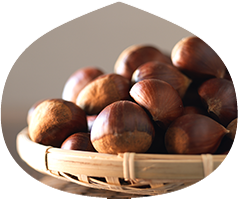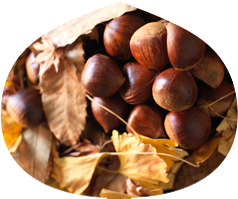The Chestnut story
The Chestnut story
Chestnuts are a quintessential taste of autumn for the Japanese. Slightly sweet but with a ‘hoku hoku’ (soft and flaky) texture, the glossy chestnuts lined up in the store represent the cool calm of fall.
The chestnuts indigenous to Japan today have an ancient origin. About 5,500 years ago, traces of large-scale chestnut cultivation were discovered at the Sannai Maruyama archaeological site in Aomori Prefecture dating to the Jomon period. The Nippon Shoki, Chronicles from the (8th century) also make mention of chestnut production.
Japan’s have been cultivated from small chestnuts called “Shibaguri” that grew naturally throughout the country, and from which larger ones have been developed. The chestnuts became particularly hearty and aromatic.
During the Sengoku Jidai (the Warring States period of Japan) soldiers were commonly rationed ‘Kachiguri’ dried chestnut. The foodstuff was high nutritional value and seemed to played a role in enhancing command. Since then, chestnuts have widely been used and loved by the Japanese from the Jomon period to the present day.
Chestnut nutrition and efficacy
Chestnuts differ from culinary nuts in that they contain less fat and are made up of 40% carbohydrates (starch), similar to cereals, and are a very good source of vitamin C. They also contain B vitamins and dietary fiber.
Chestnuts are a good source of minerals such as potassium and magnesium, and contain others for health such as phosphorus, zinc, and iron.
As an effect
Dietary fiber: Aid digestion and relieves constipation
Potassium: Suppresses hypertension and arteriosclerosis
Folate: Anemia prevention by hematopoietic effect
Vitamin C: healthy skin and regeneration
Tannin: Potential antioxidant effects
Varieties and characteristics
Chestnuts are a deciduous group of trees or shrubs belonging to the genus Castanea. There are about 12 kinds of chestnuts in the world, of which four kinds are commonly grown for their edible fruits. The
‘Waguri’ Japanese Chestnuts are large and have a hearty flavor. Compared to many other varieties the astringent skin is less likely to peel off and the fruits are easier to crack.
‘Castanea Sativa’, or European sweet chestnuts, are a little smaller and are the most widely-cultivated in the western world.
‘Chinese chestnuts, especially popular in the area around Tianjin, are known for their sweetness but small and harder to cook due to their hard and astringent skins.
‘The American chestnut was popular and of high quality, but was devastated by the chestnut blight in the early 1900s and is now listed as endangered.

